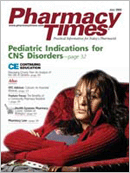Publication
Article
Pharmacy Times
Cancer: Update on Biologics
Author(s):
Biologics consist of allergenic products, antitoxins, blood and its components or derivatives, therapeutic serums, toxins, vaccines, viruses, or analogous products/derivatives applicable to the prevention, treatment, or cure of human injury or disease. Oncologists are finding many of these products?especially cytokines, cell transfer products, monoclonal antibodies (MABs), vaccines, and angiogenesis inhibitors?instrumental in the war on cancer.
Cytokines
Cytokines?proteins released by cells that react with receptors on other cells triggering a response?operate in all tissues. They often signal to indicate that cells are in the right place; without the signal, the target cell would die. Tumor cells sometimes generate their own cytokines,1 and sometimes cytokine receptors mutate or become autosignaling.2 Thus, tumor inflammatory and immune system cytokines and their receptors are germane to the neoplastic process. Interleukins, colonystimulating factors, tumor necrosis factor, and interferons represent the most studied cytokines; some are commercially available3 (Table 1).
Some of these products have helped alleviate drug-and disease-induced discomforts, allowing patients to continue with lifesaving full-dose chemotherapy and to experience an improved quality of life. Pharmacists should be aware that all of these products are proteins and therefore should follow storage, preparation, and handling instructions closely. Patients can self-administer some of these products, and they should be counseled about injection technique and storage.
Cell Transfer Products
The cellular arm of the immune system is critical for tumor cell destruction. Cell transfer products are used in autologous processes. The patient's immune effector cells are collected, cultured, and enhanced with desirable characteristics ex vivo. The physician reinfuses the activated, expanded effector cell population to immunize the patient actively or to attack the tumor cells.4 Pharmacists generally are not involved with the preparation of these patient-specific products; they are usually made in the institution's cellprocessing laboratory. The preinfusion preparatory process (eg, lymphodepleting chemopreparative regimens) and the postinfusion regimen (which may include cytokine therapy) are areas where the pharmacist may be involved.
Monoclonal Antibody Therapy
Normal cells have limited growth potential. Specific antibody-secreting cells, if cultured, die out after a few generations. To circumvent limited growth potential, scientists fuse a single antibody-forming cell to tumor cells grown in culture, creating a hybridoma. The hybridoma multiplies in vitro, producing a population of cells, each of which produces MABs?antibodies produced by identical offspring of a single, cloned antibody-producing cell.5 Several antineoplastic MABs have been approved (Table 2), and others are in development.
Because many MABs are developed from cells originating in other species, infusion reactions are common.6 Appropriate premedication with acetaminophen, diphenhydramine, and sometimes a histamine2 receptor antagonist is standard.7 MABs usually are administered via intravenous (IV) infusion and not given by IV push or bolus. They tend to have mild side-effect profiles, and they can be given in an ambulatory care clinic. Additional toxicities may be associated with combination chemotherapy. Patients should not be vaccinated with live viruses during treatment, and men and women should actively avoid reproduction. Rash is a class effect of HER1/epidermal growth factor receptor-targeted agents; rash may serve as a marker of response.8
Vaccines
Cancer vaccines have essentially the same goal as other vaccines: to actively induce cellular immune responses by generation and activation of antigen- specific T-cells. Once those T-cells are activated, the goal is to sustain that activation against tumor cells expressing the antigen until the tumor is destroyed. Vaccines traditionally have been used to prevent infectious illness, and researchers have been very successful in predicting flu mutations or drifts. Predicting cancer mutations, however, is scientifically undeveloped at this time. Additionally, untoward effects (such as secondary cancers) from prophylactic vaccination may be significant. Vaccination for cancers caused by infectious agents (cervical cancer secondary to human papillomavirus or hepatic cancer secondary to hepatitis) might respond to prophylactic vaccination. In other cancers, vaccines may be used to elicit antitumor responses, stabilize disease, or prevent recurrence of disease.9 To date, active immunization with a variety of cancer antigens has shown the ability to generate immune T-cells, but translation of this immune response to an antitumor effect has not been routinely demonstrated.
Angiogenesis Inhibitors
Angiogenesis?the growth of new capillary vessels from preexisting vessels?is a normal process. Researchers have noted the increased vascularity of malignant tissues for decades, but it was only in 1971 that a researcher proposed that tumors may be dependent on neovascularization. Inhibition of angiogenesis moved to the forefront.
Direct and indirect antiangiogenesis agents differ:
1. Direct angiogenesis inhibitors target microvascular endothelial cells that are recruited to the tumor bed and prevent them from responding to various endothelial mitogens and mutagens.
2. Indirect angiogenesis inhibitors target proteins such as epidermal growth factor tyrosine kinase and its products, B fibroblast growth factor, vascular endothelial growth factor, and transforming growth factor alpha, or their receptors, on tumor cell endothelium.10
Thalidomide, bevacizumab, and cetuximab are FDA-approved angiogenesis inhibitors. Antineoplastic angiogenesis inhibitors differ from conventional cytotoxic chemotherapy. Targeting cells that support tumor growth is particularly promising, because these cells are genetically stable and less likely to accumulate mutations (as neoplastic cells do) that lead to rapid drug resistance. Tumors respond to antiangiogenesis agents regardless of their vascularity or growth rates, but rapidly growing tumors require higher angiogenesis-inhibitor doses. Angiogenesis inhibitors are most effective when administered on a dose schedule that maintains a constant concentration in the circulation instead of a schedule in which therapy is periodically discontinued. Angiogenesis inhibitors generally are added to chemotherapy, radiotherapy, immunotherapy, or vaccine therapy.10
Conclusion
Biologics?in combination with surgery, radiation, or antineoplastic chemotherapy?represent the future in cancer treatment. Already, biologics have been able to improve longevity and reduce recurrence in some types of cancer.
Dr. Zanni is a psychologist and health-systems consultant based in Alexandria, Va.
For a list of references, send a stamped, self-addressed envelope to: References Department, Attn. A. Stahl, Pharmacy Times, 241 Forsgate Drive, Jamesburg, NJ 08831; or send an e-mail request to: astahl@ascendmedia.com.







